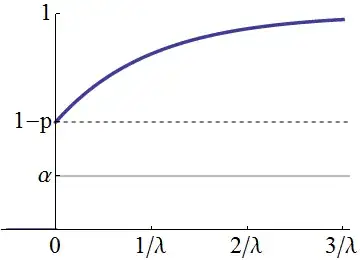I am trying to grasp what is the meaning of getting unexpected negative values for some percentiles of a mixture distribution. Let the distribution function pdf be:
\begin{equation} f(x) = (1-p)\cdot \delta(x) + p\cdot \lambda e^{-\lambda\,x} \cdot H(x) \end{equation} where $p$ is the probability of the value of $x$ being modeled as an exponential function and $(1-p)$ the probability of it being equal to zero. Also, $\textit{delta}$ and the $\textit{Heaviside step function}$ are the indicator functions of the intended supports.
If we integrate $f(x)$ from 0 to C, where C is the value of of the $n_{th}$ percentile, we can express C as:
\begin{equation} C = \frac{ln(\frac{1-n_{th}}{p})}{-\lambda} \end{equation}
My question is: provided that the expression of C is correct, $C < 0$ whenever $(1-n_{th}) < p$.
Probably I am not properly deriving the expression of C, specially regarding the integration of the $\textit{delta}$ function. If that is not the case, what is the meaning of a negative valued percentile when the support of both distribution functions is greater than or equal to zero?

